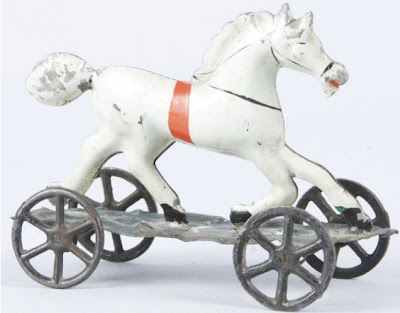When most people think of antique collectors, they imagine bespectacled old biddies peering at the underside of a sofa. Well, there are people like that, of course, but there are lots of other types, too, collecting a slew of interesting items--including toys.
Now, "toys" is in and of itself an extremely broad category. Be that as it it may, there is one auction house seems to have EVERY kind of toy up for bidding at some point during the calendar year:
Dan Morphy Auctions, out of Denver, PA. Dolls, comic books, toy soldiers, marbles, cast iron banks, sports memorabilia--if it elicits a pang of nostalgia, then Dan Morphy probably specializes in it.
On August 12th and 13th, the auction house has its Toy, Marble and Comics Auction (each day is listed separately: the 12th
here and the 13th
here). Here are some highlights.
Now, I have discussed scale before, and how it is so IMPORTANT to really make sure you read and process and map out the measurements. Here we have a great example why. The Bel-Air car up top is actually a 38" pedal car, that a child sits in, whereas the Tonka truck, directly above, is a 13" toy car. Can you tell the difference at a ready glance? Not so much.
On the subject of cars and trucks, a popular one at toy auctions, of course, we also have these two great finds.
If you like the occasional toy but don't want to come across as socially awkward as the 40 year old virgin, don't devote rooms to the stuff, just incorporate a few fun vintage pieces into your decor. Above the bookcase is a classic spot, of course...
 |
| photo: William Waldron; designer: T. Keller Donovan for Elle Decor. |
...as is throughout the bookcase, below. I love how this designer did a row of vintage pottery on the top shelf, for color, then interspersed other pieces with the books, adding textural and visual interest to an otherwise Spartan decor.
You can also collect for color and then integrate toys into that collection, as Martha Stewart shows us how to do here.
Boats can always go in the bathroom: on brackets flanking the mirror, above the medicine cabinet, or on a shelf lined wall, where you can have a revolving collection of nautically themed items.
 |
| photo: Dominique Vorillon, designer Jacques Grange, courtesy of Elle Decor. |
Now, since these are toys, we're talking about, one obvious place to put them is in a child's room. Young children, of course, will find it too hard not to incorporate their collected items into the toy box. But older children, typically age 11 and beyond, can often become great collectors. And keep in mind that collecting teaches them some important traits: how to take care of something they value, how to study and learn about a topic, how to set goals and achieve those objectives.
 |
| photo: William Waldron, designer Randall Ridless, courtesy of Elle Decor | | | | | |
|
|
|
|
|
|
|
|
|
|
|
|
|
|
|
|
|
|
|
|
|
|
|
|
|
|
|
|
|
|
|
|
|
|
|
|
|
|
|
|
|
|
|
|
|
|
|
|
|
|
|
|
|
|
|
|
|
|
|
|
|
|
|
|
|
|
|
|
|
|
|
| | |
|
Look at this little girl's room, above. It has stuffed animals today, but as she grows older, she could start to ease of of the plush toys and start to fill her shelf with collectibles.
Maybe she'll become obsessed with Fred Flintstone (feel old yet?)
Or cast iron banks (note the good motto for a child's room: "Be Wise Save Money").
Platform toys?
Note how great a vintage pull toy, not unlike the one above, looks on the dresser of this lovely room, below. The window is a great backdrop for another antique find. (P.S.:the beds are a modified lit a la Polonaise made by Neirmann Weeks. Love those too.)
 |
| photo: Peter Estersohn, designer: Katie Ridder, courtesy of Elle Decor. |
There are few little girls who aren't charmed by paperweights. Michaan's in Alameda, California, has several nice ones up for sale in their 20th C. Decorative Arts auction on August 12th, a few of which appear below.
And finally, I'm including an item that took me down memory lane: does anyone remember the Brownies? This ladder, shown in two parts, is just adorable!














































